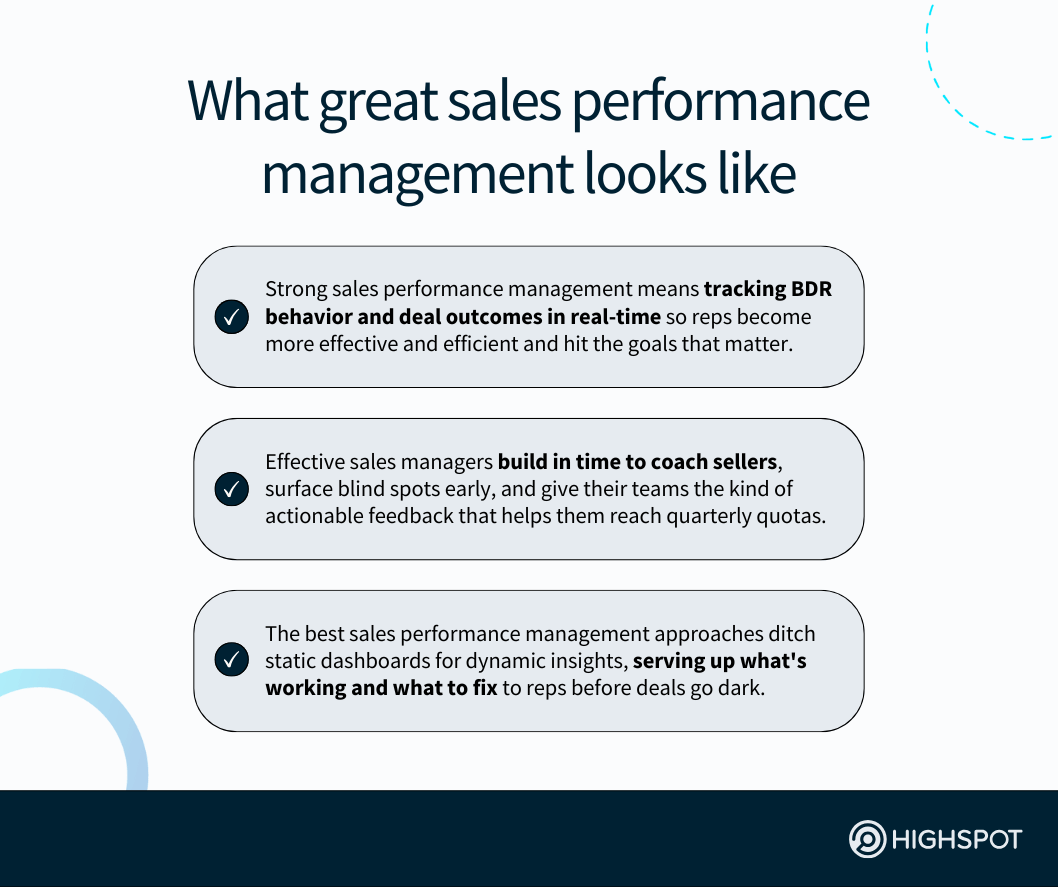Key Takeaways
- Sales performance management (SPM) helps you go beyond the leaderboard, giving you the pipeline data, coaching signals, and tools to replicate what top reps do best, right across your team.
- Building a dedicated sales performance management plan means aligning training, incentives, and insights to behaviors that actually drive revenue, not just merely rack up rep activity metrics.
- With leading sales performance management software in your GTM tech stack—including an AI-powered enablement platform—you can track smarter, coach faster, and grow stronger, one rep and deal at a time.
Sales performance management has come a long way from the days of quarterly spreadsheets and crossed fingers. It’s either a frontline advantage for you, ensuring each individual sales representative is set up to succeed—or a blind spot.
You and others in sales leadership know what’s at stake: deals, revenue, and the ever-slippery goal of hitting your number without burning out your best people.
Done right, sales performance management isn’t micromanagement.
It’s modern-day mastery: a way to help BDRs learn how to hit sales quotas consistently and, in turn, drive stronger, more predictable go-to-market results.
With robust sales analytics in your GTM tech stack, you get an objective lens into how reps show up and where deals go off track, all while empowering your entire sales team to drive consistent top-performer execution without becoming robots.
The trick? Zoom in on what each sales rep requires to grow, adapt, evolve, and win, while also zooming out to spot big-picture patterns that can help you pinpoint problem areas and growth opportunities to drive better sales outcomes.
That’s the beauty of using historical and real-time sales data: You spot signals, spark action, and get ahead of GTM performance dips before they sink your quarter.
As long as you have the right tools, tracking (and steadily improving) sales performance isn’t some mystery. It’s a science you can master. All you have to do is leverage relevant, data-driven insights to make smarter, data-driven decisions.

What is sales performance management?
Sales performance management focuses on driving stronger individual and team performance through structured planning, coaching, and measurement. It helps B2B sales leaders set realistic sales targets, align their reps to company goals, and boost operational efficiency across the entire go-to-market organization.
At its core, sales performance management is about using relevant and accurate data tied to day-to-day rep activities so managers can track and take action on actionable insights. Their sales planning becomes sharper, sales processes run smoother, and GTM enablement efforts translate into real revenue impact.
Many B2B sales organizations use ‘SPM’ today to unify frontline execution, improve pipeline visibility, and hold sales teams accountable to the right behaviors.
Implementing sales performance management solutions that support real-time feedback, dynamic coaching, and targeted reinforcement is now table stakes.
Key components of sales performance management strategies today
Regardless of the sales performance management systems you onboard, you can only help your reps meet (or, ideally, exceed) sales quotas by keeping these key components top of mind when setting targets and creating improvement plans:
- Sales goals and benchmarks: Set the bar, then let your team pole-vault over it. Ambitious yet attainable sales goals keep reps motivated and accountable, while benchmarks offer leadership a reliable pulse check on who’s pacing, who’s surging, and who needs a nudge.
- Territory and account alignment: Put the right people in the right places with the right expectations. Reassigning sales territories based on current potential (not last year’s headcount map) helps reps focus their energy and your org cover more ground with fewer gaps.
- Activity tracking and analytics: Zoom in on the daily grind to unlock big-picture wins. When every call, click, and pitch is captured and contextualized, you get clarity on how deals move—or stall—and your team learns which moves are worth repeating.
- Sales performance dashboards and KPIs: Give your team a scoreboard they actually want to check. Visibility into key performance indicators creates alignment, adds urgency, and makes it easier to coach, course-correct, and celebrate the right wins at the right moments.
- Forecasting and pipeline visibility: Read between the CRM lines. Strong sales forecasts are born from layered, structured data—rep performance, deal velocity, conversion rates—and help you steer revenue conversations with precision instead of polite optimism.
- Rep skills development and training: Turn shaky pitches into sharpened instincts. Personalized coaching tied to real-world selling scenarios helps your sales team members develop mastery in the moments that matter, not just check the LMS box and move on.
- Compensation and incentive design: Align the payout with the playbook. Implementing incentive programs that reward strategic behaviors, not just end-of-quarter heroics, drives better execution and helps embed your sales strategies into daily motions.
- Customer-centric performance metrics: Measure what matters to your buyers, not just your board. When you factor in customer expectations and customer satisfaction, you start scoring your team on outcomes that extend beyond the signature.
- NPS and customer feedback integration: Use every score and sentiment as a signal. Instead of letting NPS data sit in a dashboard graveyard, fold it into how you coach reps, tune messaging, and evolve your go-to-market strategy based on what customers actually value.
- Strategic planning and insights: Equip yourself to plan the next move before the market shifts. Long-term sales planning powered by real sales insights—and anchored in both internal business objectives and external market trends—keeps you one step ahead, always.
One nuance to sales performance management that too many GTM leaders neglect to factor into their managerial efforts is the experience levels of sales reps.
Tailoring your sales management by career stage can pay big dividends.
“By adding career stage to your talent management framework, you create a more personalized, realistic approach that meets salespeople where they are in their journey—resulting in better engagement, retention, and long-term performance across your entire sales organization,” a trio of leaders at globa professional services firm ZS recently wrote for Harvard Business Review.
3 key benefits of sales performance management for go-to-market leaders
Simply put, with the right sales performance management process, you can:
1. Scale what works best with savvy sales management
With a dedicated, insights-centric sales performance management plan, you can move from trial and error to a scalable, strategic approach to revenue growth.
That’s because you’ll finally have the visibility to see what’s clicking, what’s stalling, and how to clone your top performers across your whole sales organization.
Best-in-class sales performance management systems help GTM leaders like you monitor individual performance, team trends, and market momentum.
These sales tools also help you assign sales territories that align with company objectives, allowing your team to hit their stride faster in every region.
Using a sales enablement solution like Highspot, specifically, you can leverage AI-powered insights generated in our agentic platform for GTM teams to turn every spoken, shared, and shown signal into actions that drive better performance.
2. Use rep performance data to inform sales forecasting
Sales forecasting gets sharper when it’s driven by performance data, not pipeline padding or wishful thinking. You can track how well reps convert at each sales cycle stage, then use that data to predict future sales and revenue more confidently and with greater precision.
Instead of guessing how many salespeople you need to meet next month’s or quarter’s numbers, you can use core sales metrics and KPIs tied to seller performance to build smarter headcount models and enhance your resource allocation.
That insight also helps you inform your sales quota management efforts and ensure BDRs are set up for success based on realistic conversion benchmarks.
As a B2B sales leader, that means less fluff, more foresight, and fewer painful re-forecasts that make your boardroom feel like a courtroom.
3. Prove GTM impact with data tied to sellers’ activities
You need to connect sales activities to outcomes if they want to prove they’re moving the needle. The right tech gives you visibility into how enablement, content, and training programs directly impact pipeline movement and deal success.
Notably, tools like sales scorecards can help you develop strategies to fuel GTM performance using real-time, behavioral data, seller adoption metrics, and closed-loop reporting.
That same level of visibility and transparency allows you to build incentive compensation plans that reward high-impact behaviors aligned with company goals.
Revenue operations teams benefit from this too, as they can glean performance insights that help eliminate silos and align sales, marketing, and enablement priorities.
When RevOps leaders can quantify what’s working—in other words, what’s directly influencing deal closings and revenue acceleration—they become strategic accelerators, not just scorekeepers, across your entire go-to-market motion.
| Types of sales performance management software | How it helps sales leaders |
| AI-powered sales enablement platform | Equips sales reps with the right content, guidance, and training to execute consistently and win more in every customer interaction |
| Rep performance scorecard solution | Give sales leaders visibility into sales team performance trends so they can coach effectively and replicate what’s working at scale |
| Sales coaching and training platform | Help sales managers reinforce critical behaviors through structured feedback that builds confidence and drives skill development |
| CRM-integrated activity tracking system | Empowers sales operations to track sales activities in real time, revealing where reps are spending time—and where that time pays off |
| Forecasting/pipeline analytics software | Enables smarter sales planning by turning current pipeline data into accurate projections that improve execution and resource allocation |
| Deal and meeting intelligence platforms | Lets leaders set clear sales targets and monitor progress, keeping everyone aligned and focused on the metrics that matter most |
| Sales incentive compensation software | Uses AI to surface deal intelligence from conversations, helping reps adjust in-flight deals and stay aligned to evolving buyer needs |
| Quota attainment tracking systems | Ties sales incentives to strategic outcomes, motivating reps to focus on high-impact behaviors that directly support business goals |
Why measuring sales performance matters
‘You can’t improve what you don’t measure.’
That’s a fairly old adage.
But it still rings true with leaders at modern sales organizations who need to make data-driven decisions that help ‘on-the-ground’ GTM teams execute smarter near term and empower them to contribute to company goals tied to revenue and expansion long term.
That’s where an effective sales performance management strategy enters the equation.
With such a plan in place, you and other sales leaders can use data-driven insights to elevate how your reps reach out to and resonate with members of your target audience.
Advanced analytics unearths sales trends and patterns
Using best-in-class sales performance management software helps leaders uncover future sales trends and identify what consistently drives success.
It’s vital to keep tabs on both individual and team performance when trying to decode which patterns predict strong sales outcomes across the funnel.
By analyzing a defined set of key performance indicators, you and other sales leaders can track specific sales activities that either accelerate deals or slow them down.
With deep analytics, it’s easier to pinpoint what’s working across each sales territory and understand where attention and resources need to shift.
You can also leverage your real-time sales insights to steer initiatives in-flight and execute more impactful sales strategies with greater precision and speed.
That’s what makes sales performance management important: It gives you the data to drive smarter decisions before pipeline problems turn into missed quarters.
Insights can inform sales training and coaching needs
When metrics highlight gaps in key behaviors, you can focus coaching where it counts and support each sales rep with more relevant and timely development.
It becomes easier to realize your quarterly sales goals when you’re tuning sales training to what the data actually says—not what legacy onboarding dictates.
To boost each BDR’s sales productivity, you need visibility into what’s slowing them down and what knowledge would help them break through.
Highspot makes this easy with AI-powered training paths that adjust based on how reps perform in role plays, real calls, and lesson completions.
With smart feedback and AI-enabled rep assessments, your managers can zero in on weaknesses and coach confidently, without playing guessing games.
“An AI-powered, data-driven, and multi-modal training approach centralized around skill coaching allows organizations to achieve training consistency, reinforce learning for long-term retention, and optimize the performance of their sales teams,” per Highspot’s Grow Revenue with Sales Readiness That Delivers Wins guide.
Everybody wins when seller coaching is automated, actionable, and built into the solutions your sales team already uses every day to learn, pitch, and grow.
Sales professionals learn winning behaviors and skills
Reps who consistently close are usually doing a handful of things right—measuring performance helps surface those patterns for the whole team.
Sales forecasting tools reveal which sales activities correlate with consistent conversions, velocity, and win-rate improvements. By knowing what top performers do across each sales territory, you can coach others to adopt those behaviors and build stronger selling habits.
Defined rep coaching paths allow everyone on your sales team to sharpen their skills.
With Highspot’s AI Role Play and instant feedback, reps get personalized practice that adapts to their performance. That means every training moment gets smarter over time, helping reps develop stronger instincts, better habits, and skills that stick.
Customer relationship management becomes smarter
Customer insights tied to sales metrics are more than helpful—they’re the foundation of every high-impact sales strategy your team can actually deliver on.
Measuring performance enables your team to identify which behaviors drive better engagement, stronger relationships, and stickier sales outcomes.
It’s about aligning performance metrics with the human side of selling: relationship depth, deal timing, and buyer intent signals across the cycle.
Each sales rep can adjust in real time based on the latest CRM signals and performance data that tell them who to prioritize and how to tailor their outreach.
Smart integrations with GTM platforms like Highspot ensure those insights live where reps already work, so every move they make is smarter and more precise.
When data and relationships finally speak the same language, your entire sales team can move with more confidence and close deals that last longer.
How to unlock greater sales productivity by measuring each reps’ performance
Highspot’s State of Sales Enablement Report 2025 found enterprise companies with well-integrated GTM technology stacks are 42% more likely to increase sales productivity than large businesses with poorly constructed tech ecosystems.
New go-to-market tools seemingly emerge weekly. But it’s evident the most impactful GTM solution is an enablement platform that—well—enables you to:
Track behaviors that drive results, not just activity
Sales performance management helps you zoom in on actions that move revenue forward—not just the stuff that clutters a sales dashboard or bloats a CRM.
By identifying which reps are consistently executing the behaviors that lead to closed-won, you’re able to focus coaching where it actually matters.
It’s time to move past vanity metrics and start obsessing over behaviors that consistently turn “thinking about it” into “signed yesterday.”
Instead of tracking email volume or meeting count, look at response rates, conversion stages, and sales velocity to uncover what truly drives momentum.
That’s one of the key components of sales performance management: separating noise from signal so reps can double down on what actually works.
Tracking smarter means you free up time, increase your sales reps’ confidence, and give your team the playbook that gets better every time it’s run.
Leverage sales scorecards to ID growth opportunities
A good sales scorecard doesn’t just show you who’s winning. It reveals why they’re winning, where others are struggling, and how to close that gap.
Sales performance management puts those insights front and center, giving you coaching-ready data with zero digging, filtering, or dashboard spelunking.
When everyone knows what “great” looks like, it’s easier to replicate it across the board, not to mention spot when someone’s about to break through.
Sales intelligence from scorecards, tied to defined key performance indicators, allow you to zoom in on conversion, engagement, and skill gaps quickly.
And when you tie those insights back to specific sales activities that matter, you start coaching to outcomes, not just general effort. Better yet, you’ll always have something valuable to bring into a 1:1 besides “So… how’s the pipeline looking?”
Develop adaptive learning paths tailored to each rep
Sales performance management gets a serious glow-up when reps are learning what they need, not just clicking through what they’ve already mastered.
Highspot’s Adaptive Learning personalizes content and coaching by analyzing where each rep is today and where they need to go to reach full potential. Our platform delivers just-in-time guidance to sellers that is rooted in real selling moments.
With Adaptive Learning paths set up for each rep on your team, learning is no longer theoretical. It’s tactical, tailored, relevant, and directly tied to performance.
Instead of dragging your sales team through a one-size-fits-nobody training schedule, you can create high-impact paths that meet them in their moment.
The system adjusts training based on skills, pipeline stage, and engagement signals, giving you smarter ramp and sharper retention without extra admin.
With Adaptive Learning at reps’ fingertips, you turn training from a chore into a cheat code—and that’s when your reps start learning to win (and at scale).
Automate your sales performance feedback loops
Sales performance management doesn’t have to mean hours of manual spreadsheet wrangling and late-night Slack messages asking, “Did we hit that number?”
Automating your feedback loops with smart systems means less checking boxes and more checking progress—and way faster recognition of what’s working.
With Highspot, you can close the loop on training, coaching, and execution without adding another tool or to-do list for reps. You’ll increase operational efficiency of inside and field sellers by letting the system serve up insights while you focus on strategy.
No more playing “Where’s Waldo?” with metrics. Just real-time performance visibility, in-line recommendations, and actions tied directly to outcomes.
That way, every feedback cycle becomes a performance accelerator, not a post-mortem.
Surface warning signs and take proactive measures
Sales performance management is most powerful when you see what’s going sideways before it nosedives—and that’s exactly where Highspot Agents shine.
Highspot Agents leverage Nexus™, our AI and analytics engine, to detect patterns across what’s spoken in conversations, shared in content, shown through buyer behavior. They serve up answers and actions that drive stronger sales performance without requiring you to play whack-a-mole with 15 disconnected tools.
The Deal Agent, for example, acts like having an expert deal strategist by their side at all times, delivering AI-powered insights to prevent pipeline pain.
For sales managers like you, this means less reacting and more proactive guiding.
You can spot the slowdown early, take the optimal steps to act fast, and keep the motion going strong across every single sales territory your organization covers.
Incentivize sales compensation tied to reps’ quotas
The smartest incentive plans don’t reward noise—they reward progress, consistency, and reps hitting the marks that align with your growth strategy.
Sales performance management lets you align quota and comp with behavior, not just closed deals, so everyone knows what earns rewards (and why).
With tools for incentive compensation management built right in, it’s easier to match payouts with priorities across every region and rep tier.
When you implement data-backed incentive compensation plans your reps actually believe in, behavior changes in the best possible way. They don’t just chase numbers.
They chase the right moves that get them paid and push the business forward.
Use AI role play to give reps real-world experience
If you want reps ready to crush it live, you’ve got to let them rehearse under pressure. That’s where Highspot’s AI Role Play comes to life.
Sales performance management gets personal when reps can practice real objections, tough personas, and tricky scenarios without needing a manager on standby.
Highspot uses data from across your sales tech stack to inform role-play responses, feedback, and progression in real time. It’s like running scrimmage plays with a coach who sees your last three games and already knows what you need to practice next.
Your reps sharpen skills fast, without waiting for calendar availability or feedback three weeks late. The experience is designed to simulate real conversations and deliver feedback reps can apply on the very next call—with confidence and clarity.
Adopting an AI-powered approach to sales performance management
“Siloed operations are the canary in the coal mine for organizations,” according to our most recent State of Sales Enablement Report. “A unified enablement approach—with a connected experience, analytics, and AI—eliminates silos and equips go-to-market teams to execute more effectively, together.”
Translation? Your sales performance management will suffer without artificial intelligence at the core of your tech environment and embedded in your GTM operations.
We’re well beyond the point of thinking AI for sales, marketing, and enablement is simply a nice-to-have. It’s now a business-critical resource that you need to consistently elevate your go-to-market performance and eliminate any GTM execution gaps.
If you’re not already capitalizing on the immense power of AI, you’re falling behind competitors who are wielding advanced analytics and agents to bolster pipeline management, evaluate market trends, build smarter incentive compensation plans, and tackle a myriad of other business-critical GTM activities.




